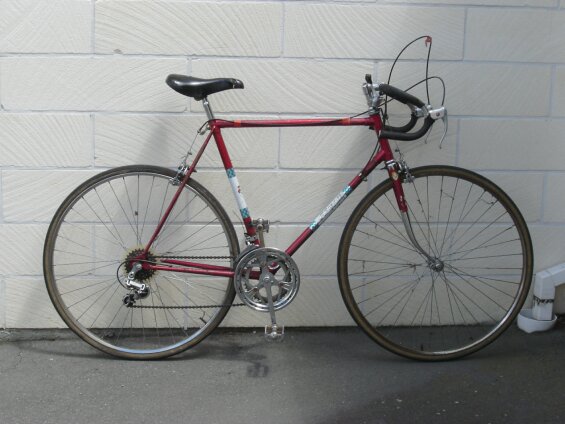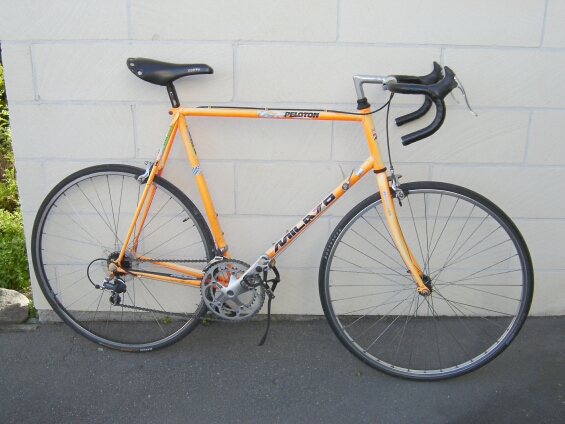Some thoughts about fixed-gear conversions, and building a fixie (fixed-gear bike) in New Zealand.
Modify an existing bike, or build from parts?
It might be best to start out considering how much time and money you wish to spend on the bike. Things always seem to take longer and cost more than originally anticipated. Aim a little on the low side just in order that the bike gets finished. There is nothing worse than a half-complete bike hanging around and being in the way for the next two years, or progress stopping due to lack of funds!
In my experience, modifying a complete bike to be a fixed gear is easier than sourcing parts (frame, wheels, bars, etc.) and building it yourself. Not necessarily due to the complexity of putting it together, but because of general incompatibility between parts. If you have a fair idea of what parts you are looking for, then all good and well, but if you're not aware (for just one example) of the different bottom bracket spindles available, you may well buy a bottom bracket to which your cranks will not fit. If parts were free, it's no great loss as they can go in the parts bin for another project, but particularly when buying new, it would be a shame to buy something that will not fit. This is why I suggest modifying a complete working bike where you know that the handle bars fit the stem, the stem fits the frame, the brake calipers are the right reach for the wheels, etc.
Buying a bike on TradeMe
TradeMe has many suitable bikes, though prices can vary quite a lot! Anything with Campagnolo parts tends to have an inflated price (this is at least partially to do just with the name; in the same way Porsche car parts are expensive). Old track frames and complete bikes also seem to go for quite high prices. An old 70's Dutch track bike (admittedly possibly with some history) recently went for $500, which seems like quite a lot to me if you're just after a decent bike. If you look towards the mid 90's however, there are many steel frame bikes that go for a song. I picked up an old Giant RS940 with triple-butted steel frame in excellent condition for a lot less than $100. It has short semi-horizontal drop-outs that are long enough for single-speed/fixed-gear conversion. Another common bike on TradeMe from that era is the Avanti Sprint. I believe these are also well suited to fixed gear conversion.
What fixed-gear specific parts do I need?
The only fixed-gear specific part is the rear cog. If you are lucky, the rear hub on the bike will already be the screw-on type that accepts a freewheel; the cog can be threaded straight onto this hub after first removing the multi-speed freewheel. Some people like to either fix the cog in place with locktite to prevent the cog unscrewing when you back-pedal (essential if you have no brakes!). If the bike is 80's or older, it will have a screw-on rear hub. Many bikes changed to the stronger freehub style rear hub some time in the 90's; these cannot be converted to fixed gear by just screwing on a single rear cog as the thing will still freewheel. For a fixed-gear conversion it's probably best to look for an 80's bike or earlier. That way you can hopefully save a bit of grief by already having a suitable rear hub.
Steel frame, or aluminium?
Steel (steel alloy) or aluminium (aluminium alloy) both work, but steel does have the advantage that it can be bent. So if you need to re-space the rear of the frame, you can do this with a steel frame but not an aluminium one. It's usually only necessary to re-space the frame though if you wish to make a particular width rear hub fit in the frame and usually this is not necessary.
Must I find a frame with horizontal drop-outs?
Longer length near horizontal dropouts are good, though not always essential (my First Gear software will let you choose something to fit even vertical dropouts). Having said that longer dropouts let you adjust for chain wear a lot easier, and will generally make like easier. Easier is good, so nice long drop-outs as near to horizontal as possible are good!
Other considerations for the frame
The most important aspect, would be to first choose the style you want; mountain bike, road, or track (normal or low-profile). Low-profile track frames with downward sloping top tube look funky, can sometimes be had quite cheaply, but are really painful to ride! Next, getting the right size is crucial to riding happiness. You can use First Gear, or even a good cycling book from the library to figure out what size frame to look for.
Are parts easy to find in New Zealand?
In New Zealand, my thoughts on parts are that they are available, but can be rather expensive. Yes, there are certainly shops where you can go and touch and buy just about all the parts you need, but if you're buying parts for a whole bike you can save a bundle by ordering from some place like Harris Cyclery in the US. On the other hand, if you really want to see the thing in the flesh local bike shops are great. Plus you can do things like try parts out for size and fit; something you cannot do via the Internet.
Should I look for a particular brand bike?
I'd say look for well known brands like Giant, Marin or Avanti etc. They tend to have a good frame/parts quality balance. The frame also will have a decent finish with decent brazing/welding. Sometimes bikes that look good from a distance are real rubbish; my old Estremo Delta for example. Eswhat whatwhat?
There are quite a few older ten speeds for sale on places like TradeMe. While also OK for converting to fixed-gear, I tend to steer away from them because they are often of lower quality than a proper racing bike. Strangely enough, these low end bikes often sell for quite high prices. If you see something with the name Healing, or Worldrider, it's probably one of these bikes, but companies like Healing also made a few high end bikes too, so how do you tell the difference?
- Low end ten speed: The gear levers are mounted on the handlebar stem. There are brake levers that can be operated from the flats on the handlbars (called suicide levers because they don't work very well) as well as on the drops. They have 27 inch wheels, usually made from steel (heavy and a poor braking surface in the wet). The crank and chain-rings are probably permanently fixed together meaning you have to swap the whole thing if you want to change it; a chain guard is often visible on the outside of the largest chain-ring. They usually have mud guards.

Gear change on handlebar stem, cottered crank with chain guard
- Proper racing bike: The gear levers are on the down tube. The only brake levers are accessible from the drops of the handlebars. Wheels are usually 700C (marked 622 x something on the tire) and are aluminium alloy (light and a better braking surface in the wet than steel). The crank and chain-rings have five bolts holding them together; these can individually removed for customisation. There are no mud guards, and the brake callipers therefore can have shorter arms for more braking force. One downside, the frame will possibly not accept very wide tires, so if you want nice big soft shock absorbing 622x38 tires or similar, a racing bike frame will be out. In this case you should look at hybrid frames which run big road style 700C tires but flat handlebars and mountain bike componentry; but that's a topic for another day!

Gear change on down-tube, 5-bolt crank, short reach brake calipers
Unless there is a good reason, a proper racing bike is usually much more satisfactory than a cheap ten speed in my experience.
Oh, one other hint; the cheap bikes usually have ten gears. Decent racing bikes, unless they are really rather old tend to be twelve or fourteen speed.
Raleigh sounds like a good brand
Old Raleigh bikes are another group that sometimes pop up in odd places (like TradeMe). The Yellow Bird conversion is one of these. There are a number of things to watch out for! Firstly, they use different thread sizes to everyone else. Renewing a headset means finding a replacement, and they're no longer being made... Also (though not limited to just Raleighs) they often have cottered cranks, meaning there is a cotter pin that holds the crank onto the bottom bracket spindle. This can be rather difficult to remove after it has been in there for thirty years! Also, the chain-ring is usually fixed to the crank, so changing the chain-ring means changing the crank. Fortunately the chain-rings on such bikes are made from steel and last a long time, but if you want to fiddle with gear ratios it's just another thing that makes things difficult.
Finding a real bargain?
Sometimes a great deal can be had on TradeMe buying a bike that is complete, but is not a runner. Many people want a bike they can hop on and immediately start enjoying. If the chain is hanging loose and both tires are flat (maybe they just need to be pumped up!) many people will pass on the auction. For the enthusiast it might not take much to get the bike running at all.
Beware about going too far with this train of thought though as it can turn into a can of worms. Maybe a rough running hub means a new hub, which means new spokes, and if you're changing the spokes maybe the rim isn't worth re-using, and then wouldn't matching wheels be nice, and matching cranks custom anodised...
It reminds me of a photo I once saw in a classic car restoration magazine. It showed a rusty fender and perhaps one or two other vaguely identifyable parts amidst scattered rust flakes out in the middle of the desert. The caption read... sometimes it really is too late.
Copyright 2006-2008
Martin van den Nieuwelaar
Last updated 25 Jun 2013
